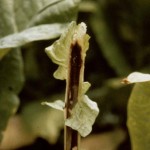Erwinia
There are no cultivars resistant to this disease.
Pictures provided by R.J. Reynolds Tobacco Company Slide Set, R.J. Reynolds Tobacco Company, Bugwood.org
Hollow stalk caused by Erwinia Carotovora, is soft rot that normally affects plants in the final stage of crop cultivation. Wounds and high humidity are normally the causes. Although the bacteria can enter the stalk through any wound or stem lesion, the wounds caused at topping and the break at the top are the main entry routes. In the leaf, the bacteria may enter at the base and then extend to the midrib, but they most commonly reach the pith, which is rapidly destroyed by a soft rot, and the stem becomes hollow. In the outer side of the plant the lesions appear in the form of dark streaks along the stem. Once the pith has died, the leaves wilt and turn yellow, and sometimes fall from the stalk.
The bacteria survive for years and they occur naturally in the soil and even on leaves of any plant, facilitating infection through wounds caused at topping and at sucker elimination. As dissemination of the bacteria is favored by humidity, so topping and sucker elimination should be avoided in cloudy, wet or rainy days. During topping, care should be taken not to touch the soil or clean the hands with soil/sand. Rainy weather increases the development of the disease.
There are no cultivars resistant to this disease, a fact that calls for preventive measures.

